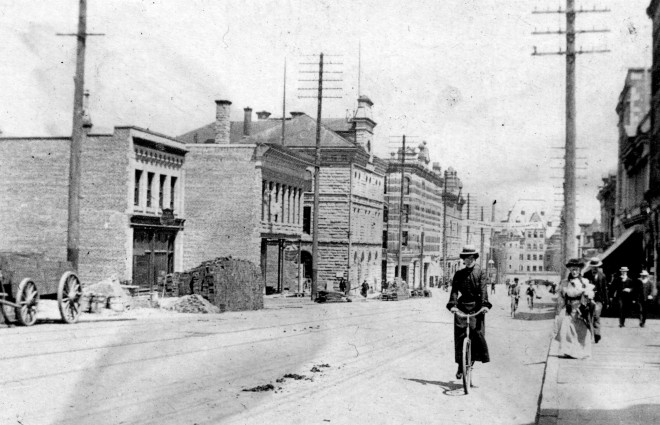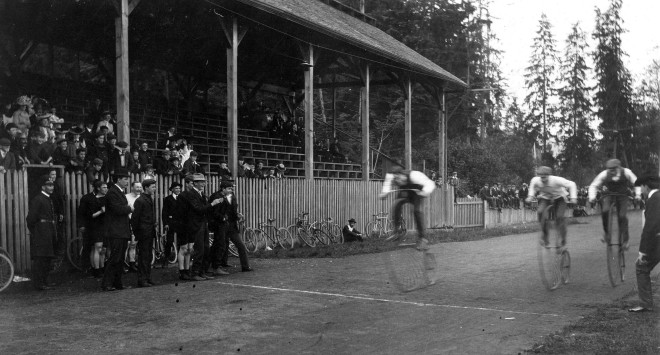
Falling Back In Love With Cycling: A Glimpse At Vancouver's Bicycle Past

Riding south on Granville Street approaching Dunsmuir Street, circa. 1900. Credits: City of Vancouver Archives.
Believe it or not, Vancouver has long been bicycle 'crazy'. Vancouverite Mark Mauchline gives us a quick history lesson before Velo-city Global kicks off next week.
The upcoming Velo-city Global conference is a new event for the City of Vancouver. In so far as this gathering of cycling infrastructure expertise, and the sharing of transportation and urban planning best practices may be new, and even cutting edge, Vancouver’s connection to the bicycle is actually old news.
The backdrop for this year’s Velo-city conference is the municipal government’s recent announcements on the permanent status of its separated bicycle lanes, improvements for existing cycling infrastructure, and the go-ahead for a public bike share program. The result has been the expected public debate, filled with a multitude of opinions. As with any democracy, all of them share the same entitlement, and not all of them agree.
"The bicycle “craze” was prevalent in Vancouver, as elsewhere, about 1900; almost every family had at least one, some had more; nearly all young men, and most young women, many elderly men and some elderly women rode"
But, these initiatives are just the latest in a long history Vancouver has shared with cycling. So it is perhaps the best type of irony that finds delegates of Velo-city Global 2012 discussing background research, experiences in implementation, and the merits attached to these same initiatives all over the world.
At the turn of the twentieth century, Vancouver was a virtual backwater. A frontier type town born earlier of a national railway known as the Canadian Pacific, it was literally the end of the line. According to longtime City of Vancouver archivist Major J.S. Matthews:
The bicycle “craze” was prevalent in Vancouver, as elsewhere, about 1900; almost every family had at least one, some had more; nearly all young men, and most young women, many elderly men and some elderly women rode. It was a convenient mode of travel in a city as yet unprovided with a full street car service; a growing city badly scattered, and among a people who, as yet, had acquired no individual wealth to speak of. Motor cars were still some years off, many had neither facilities, room, nor means to possess stables or buggies. The bicycle was no longer the unwieldy “penny-ha’penny,” big wheel small wheel affair. The “safety” bicycle had come, and with it the Dunlop pneumatic tire; and the “coaster brake” was soon coming. Both wheels were the same size now; it was easily mounted and dismounted, and a fall from it rarely gave much hurt, as the old high wheel, hard tire “wheel” did.
The bicycle became so popular that racks were put up in the vestibules of the small office buildings to receive the “machines” of those employed there and who had business there. At the City Hall, there was a long rack which would accommodate perhaps two dozen bicycles. Similar racks existed at the C.P.R. Depot, and also public places such as parks, post office and hotel lobbies. At the corner of Pender and Granville streets, where now stands the Rogers Buildings, a school for bicycle riding was flourishing...
The “machines” were so numerous that the City Council ordered special bicycle paths constructed on those streets which were most frequently used. These paths were invariably cinder surfaced, and rolled flat, and ran along the edge of the street between the gutter and wooden sidewalk. They were about six feet wide, and constantly kept in order, level and smooth, by city workmen.
The bicycle paths led to and from some well-frequented area, or beside streets where there was considerable vehicular traffic. One ran from Seymour Street, along the north side, to the entrance of Stanley Park; another on the west side of Seymour from Robson to Pacific Street; a third from Granville Street South (from the Third Avenue Bridge) from the bridge, along the north side of Third Avenue to about Maple Street, where the track turned off in an indeterminate direction through the clearing until it reached Greer’s Beach. This cinder path ended at Maple Street. There must have been others; I think there were, perhaps on Pender Street West, to the Park, on Powell Street, on Westminster Avenue leading to Mount Pleasant, and on Beatty or Cambie streets to the bridge, and then up the hill on the south side of False Creek. These cinder paths ceased as they approached the centre of the business section of that day.
Gradually, the bicycle craze died down, and the street car system was extended into even remote and sparsely settled districts; then the motor car came. The bicycle paths fell into disrepair, and finally mysteriously disappeared.

High wheel bicycle race at Brockton Point, Stanley Park, circa. 1890’s. Credit: City of Vancouver Archives
Of course, the story does not end there. Call it cliché, but cycling, and bicycle paths have fallen back into fashion. Maybe the old ways have something to contribute to our new way of life, and in the case of the bicycle, what was old is new again. In an age where it is easy to lose site of the common, and perhaps universal social benefits in the court of public opinion, the Velo-city conference aims to keep the discussion trained on the finish line of benefits that cycling represents.
With Vancouver hosting Velo-city Global 2012, what goes around has truly come around. And, with an international conference comprised of almost 200 speakers over four days and delegates from around the world, a 19th century human powered invention is being heralded as an important and necessary aspect of transportation policy and urban life – a fitting tribute as Vancouver moves forward a century and a half later.

About the Author
Vancouver resident Mark Mauchline has worked as a producer and director on critically acclaimed, award-winning television series, and documentary films since 2003 and has bicycled, hiked and paddled in thirty countries on five continents. He is the current Communications Manager for the Velo-city Global conference in Vancouver.
Contact the author
Recent news!
Upcoming events
Contact Us
Avenue des Arts, 7-8
Postal address: Rue de la Charité, 22
1210 Brussels, Belgium









